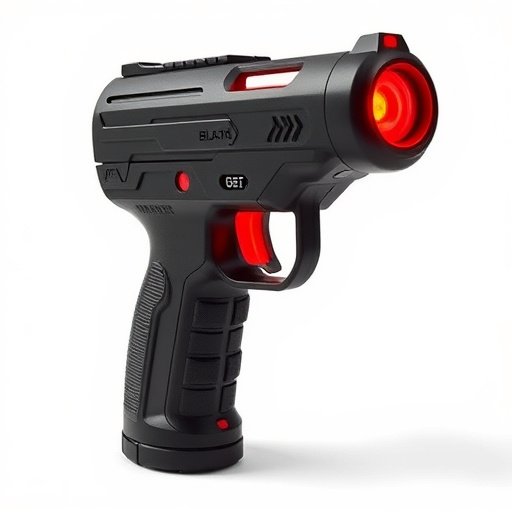Master Blaster stun guns represent innovative non-lethal force solutions, using high-energy pulses or beams to temporarily paralyze targets from a distance without causing permanent harm. They offer safety and convenience for both law enforcement and civilians seeking personal protection. Key differences between projectile (distant) and contact (direct) stun weapons include range, power, and portability. The legal status and ethical implications of Master Blaster stun guns vary globally, with many countries regulating their possession and use due to potential misuse and unintended injuries. Balancing personal safety with responsible use remains paramount as these devices gain popularity in today's security-focused world.
“In the realm of personal defense, Master Blaster stun guns have sparked interest due to their unique approach to deterring potential threats. This article explores two primary categories: projectile and contact stun weapons. We’ll delve into the mechanics of each, their advantages, and a comprehensive analysis of range, power, and portability. Additionally, we’ll navigate the legal landscape surrounding Master Blaster stun guns and discuss ethical considerations, providing an insightful guide for those seeking effective self-defense solutions.”
- Understanding Projectile Stun Guns: How They Work and Their Advantages
- Contact Stun Weapons: Direct Impact and Safety Features
- Comparing Range, Power, and Portability: A Comprehensive Analysis
- Legal Considerations and Ethical Use of Master Blaster Stun Guns
Understanding Projectile Stun Guns: How They Work and Their Advantages
Projectile stun guns, often known as master blaster stun guns, operate by projecting a high-energy pulse or beam to incapacitate a target from a distance. Unlike contact stun weapons that require direct physical contact, these devices use advanced technology to disrupt muscle control and cause temporary paralysis. The primary advantage of projectile stun guns lies in their non-lethal nature, making them ideal for self-defense scenarios where stopping an attacker without causing permanent harm is paramount.
Moreover, master blaster stun guns offer a level of safety and convenience. They eliminate the need for close proximity to the assailant, thereby minimizing potential risks to the user. This feature makes them accessible to a broader range of individuals, from law enforcement officers to civilians seeking effective personal protection. The ease of use, combined with their powerful impact, positions projectile stun guns as innovative solutions in the realm of non-lethal force.
Contact Stun Weapons: Direct Impact and Safety Features
Contact stun weapons, like the iconic Master Blaster stun gun, operate by delivering an electric shock through direct physical contact. When activated, these devices release a powerful electrical pulse that disrupts muscle control in the target area, causing temporary paralysis and disorientation. The key advantage lies in their immediate impact; once deployed, the stun gun takes effect almost instantly, making them ideal for close-quarters encounters.
Safety is another critical aspect of contact stun weapons. These devices are designed with various safety features to minimize accidental discharges and ensure user control. Many models incorporate safety switches that must be activated by the holder, preventing unintended usage. Additionally, their design often includes durable yet grippy materials, allowing users to maintain a firm hold during use, reducing the risk of injury to both the user and the target.
Comparing Range, Power, and Portability: A Comprehensive Analysis
When comparing projectile and contact stun weapons, like the Master Blaster stun gun, range, power, and portability are key factors to consider. Projectile weapons, such as stun guns that fire small darts or rounds, offer a distinct advantage in terms of distance. They can incapacitate targets from a safe, strategic distance, making them ideal for self-defense scenarios where de-escalation is crucial. On the other hand, contact stun devices, like electroshock weapons, require physical contact to deliver a shock, which reduces their effective range but increases the intensity of the stun.
Power levels also differ significantly between these two types. Projectile stun guns typically have lower power outputs, focusing more on creating a safe, controlled environment rather than severe incapacitation. Contact stun weapons, in contrast, can deliver powerful electric currents capable of neutralizing even large or aggressive individuals. Portability is another critical aspect; Master Blaster stun guns and similar projectile devices are generally lighter and more compact, making them easier to carry discreetly while maintaining readiness. In comparison, contact stun tools may be bulkier due to their high-voltage components, although modern designs have made significant strides in reducing size and weight.
Legal Considerations and Ethical Use of Master Blaster Stun Guns
The legal landscape surrounding master blaster stun guns varies widely across jurisdictions, reflecting differing societal attitudes and priorities regarding personal safety and law enforcement. In many countries, stun devices are categorized as non-lethal weapons, subject to specific regulations that dictate who can possess, carry, and use them. These regulations often consider factors such as age restrictions, need for self-defense or professional application, and the power output of the device. Non-compliance with these laws can result in severe penalties, underscoring the importance of understanding local legislation before purchasing or employing a master blaster stun gun.
Ethical considerations also play a significant role in the discourse around master blaster stun guns. Proponents argue that these devices offer a safer alternative to firearms, providing individuals with a means to incapacitate attackers without causing permanent harm. Critics, however, raise concerns about potential misuse, unintended injuries, and the escalation of situations that could lead to unnecessary violence. Striking a balance between personal safety and responsible use remains paramount, particularly as the availability and popularity of master blaster stun guns continue to grow in today’s security-conscious world.
When choosing between a projectile and contact stun weapon, like the Master Blaster stun gun, understanding their unique attributes is key. Projectile weapons offer a tactical advantage with increased range, while contact stun devices provide immediate impact and safety features for close-quarters encounters. In terms of portability, both have their pros and cons. Legally, responsible ownership and use are paramount, ensuring these powerful tools remain accessible for personal protection without causing harm to others.
